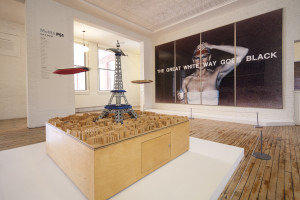Expo 1: Rio
dal 16/12/2013 al 22/2/2014
Segnalato da
16/12/2013
Expo 1: Rio
MAM Museu de Arte moderna, Rio de Janeiro
An examination of the complex interactions between ecology and economy, against the backdrop of the revolutionary changes of recent years. In addition to crucial components of the New York presentation, the exhibition incorporates works by Brazilian artists specifically selected to reflect the current local climate in 2013.

The Museum of Modern Art and MoMA PS1's Expo 1 Exhibition Travels to Brazil
A focused and updated version of EXPO 1: New York—the large-scale exploration of ecological challenges in the early 21st century that was on view from May until September at The Museum of Modern Art, MoMA PS1, and the VW Dome 2 in Rockaway Beach—is on view in Brazil as EXPO 1: Rio at the Museu de Arte Moderna (MAM) in Rio de Janeiro. In addition to crucial components of the New York presentation, the exhibition will incorporate works by Brazilian artists specifically selected to reflect the current local climate, both social and political, in Rio de Janeiro in 2013.
The original idea of EXPO 1 was developed by Klaus Biesenbach with Hans Ulrich Obrist. Luiz Camillo Osorio, Curator of MAM, collaborated for the selection of additional artists from Brazil for EXPO 1: Rio. Peter Eleey, Roxana Marcoci, and Jenny Schlenzka, among a team of additional MoMA, MoMA PS1, and independent curators, contributed in advisory roles.
The conceptual basis of EXPO 1: Rio is an examination of the complex interactions between ecology and economy, against the backdrop of the revolutionary changes of recent years. Increasing ecological challenges, innovations in industry and production, as well as structural and massive changes in societies and political balances, position the works in the exhibition as a call for public debate.
EXPO 1: New York took its urgency from an ecological view point due to the direct experience of climate change as evidenced in the concrete example of Hurricane Sandy, which gravely affected large parts of New York. In the future venues and cities where EXPO 1 will be presented, the exhibition will continue to consider shifts in each local urban environment and the uneven growth of economic progress in relation to global ecological changes. International spectacles, such as widely viewed sporting events, are often at odds with infrastructural and social needs. Carnival, an example specific to Rio de Janeiro, will be visible to a global audience in 2014, preceding both the FIFA World Cup soccer championship and, two years later, the Olympic Games. The preparations for these massive events are occurring simultaneously and present a contrast to demonstrations and riots against political and police control that express a wide-spread disagreement with the authoritarian planning.
At its center, EXPO 1: Rio focuses on works that incorporate urban parades and demonstrations. What is political can be art; what is art can be political. Matthew Barney’s video DE LAMA LÂMINA shows the carnival in Salvador de Bahia; DAS INSTITUT with UNITED BROTHERS organized a parade in radioactive Fukushima as depicted in Taiyo no tate (Sunstorm) Blue Flash/Green Flash; and the historical Ausfegen by Joseph Beuys, filmed by KP Brehmer, shows Beuys cleaning up the aftermath of the labor union demonstrations on the first of May, 1972, in Karl-Marx-Platz in Berlin.
A very contemporary comment on this topic is the video Wonderland, 2013, by Halil Altindere, which depicts three young rappers protesting the gentrification of their neighborhood in Istanbul. The work represents the public discontent with the city that plans to build an additional nuclear power station along with at least one new airport and numerous other expansions, all of which are poised to greatly impact the everyday life of its citizens. A two-channel installation by Croatian artist Igor Grubic shows a gay pride parade in Belgrade that was attacked by militant neo-Nazis on one channel, and the re-enactment of the incident using contemporary dancers on the other. EXPO 1: Rio is dedicated to the Egyptian artist Amal Kenawy, who died in 2012. Kenawy’s work combines artistic practice with a responsible and courageous role in society. Her urban intervention in 2009, in which she instructed men to parade through inner city Cairo on their hands and knees, in retrospect looks like a premonition of developments in Egypt in the years that would follow her performance.
The exhibition culminates in a work by Cinthia Marcelle, 475 VOLVER, an iconic video of a caterpillar digging itself deeper and deeper into the freshly deforested red soil of central Brazil in the shape of an infinity loop.
In collaboration with Luiz Camillo Osario, works by Jarpas Lopes, Jonathas de Andrade, Thiago Rocha Pitta, Claudia Andujar and Rivane Neuenschwander, and Cao Guimarães were added, along with seven photographs from the MAM collection by Ansel Adams, who remains one of the most historically relevant art activists of the American West.
EXPO 1: Rio is made possible by a partnership with Volkswagen do Brasil.
Press Contact:
MoMA: Margaret Doyle, (212)406-6400 or margaret_doyle@moma.org
MAM: Claudia Noronha CW&A Comunicação 5521-2286-7926 claudia@cwea.com.br
Museu de Arte Moderna (MAM)
Av. Infante Dom Henrique 85 / Parque do Flamengo / 20021-140 / Rio de Janeiro RJ
Hours:
Tuesday - Friday, 12 pm - 6 pm
Saturdays, Sundays and holidays, 12 pm - 7 pm
Adult: R$ 12.00
Student (12+): R$ 6.00
Senior (60+): R$ 6.00
MAM member and youth (12 and under): free admission
Wednesdays (3 - 6 pm): free admission
Sunday Family Pass (up to 5 persons): R$ 12.00



